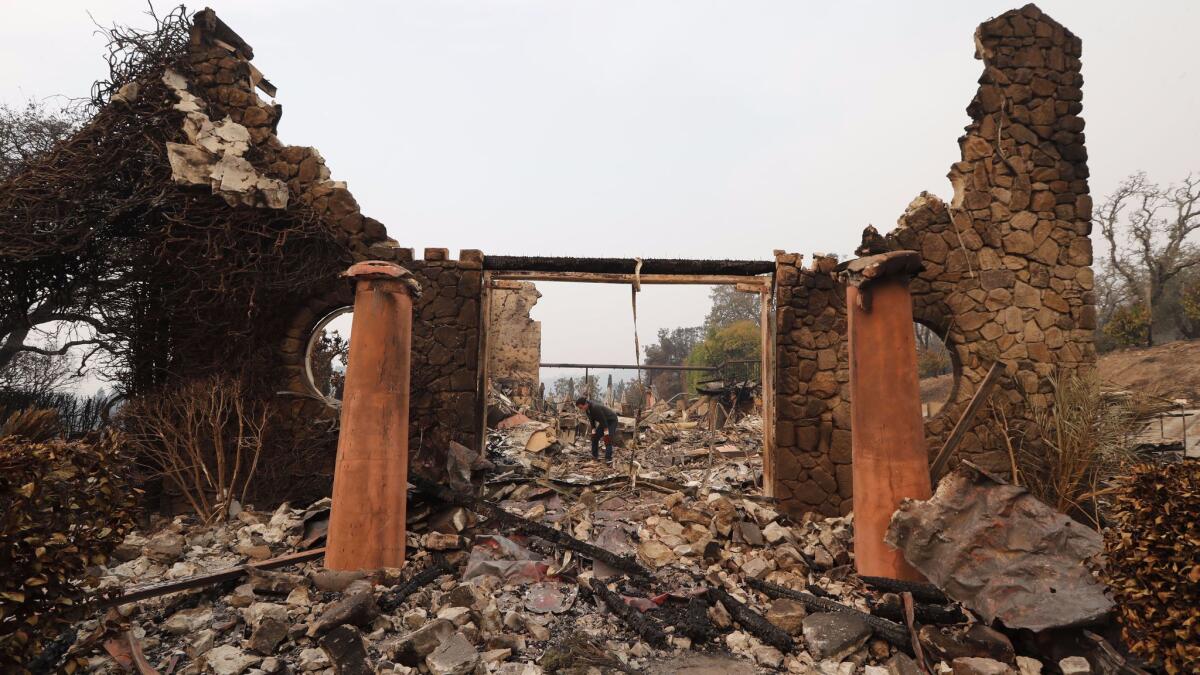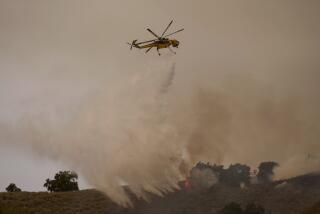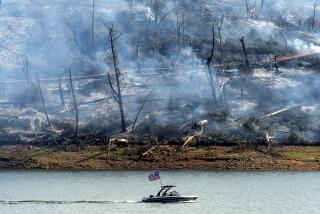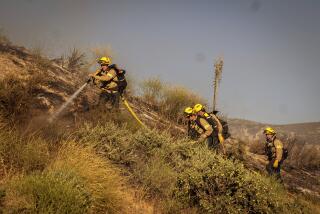Will tourists return to wine country after the Northern California fires?

Most vineyards and wineries in Northern California’s wine country have been spared by several days of firestorms, but it isn’t clear yet whether the nearly 24 million tourists who visit the region each year will want to return to charred hillsides.
Tourism officials remain optimistic, saying huge swaths of verdant wine country in the western end of the region remain unscorched and open to wine lovers. Hotels, short-term home rentals and tourist attractions there are operating as usual.
“There are parts of the county where you don’t even know anything is going on,” said Tim Zahner, interim chief executive officer of Sonoma County Tourism, the marketing organization for the region.
The fires that began Sunday in Northern California struck at the heart of the nation’s wine region — Sonoma and Napa counties, home to 1,100 wineries. California’s wine industry produces 85% of all U.S. wines, resulting in a $114-billion economic impact in the nation.
The 23.6 million visitors to California’s wine country is more than the number of fans who visit Walt Disney Co’s Magic Kingdom at Walt Disney World in Florida, the world’s busiest theme park with at estimated 20.4 million visitors in 2016. Wine making in California employs 325,000 workers.
But the full impact of the fires may not be known for weeks or months.
“Due to road passage difficulty and poor air quality, please consider making alternate travel plans until the fires in Napa Valley have been contained,” the website for Visit Napa Valley advises. Cellphone service has been spotty in the area because so many signal-transmission towers have burned.
The website listed 15 wineries and tasting rooms that remained open in the valley but 60 others that are closed. The site also lists 23 hotels that are open and 19 that are closed, including the Calistoga Spa Hot Springs in Calistoga and Carneros Resort and Spa in Napa.
“The resort has been under a mandatory evacuation as a precaution since Sunday, October 8,” the resort posted on its website. “We are grateful that no damage has been sustained and we currently do have power.”
The scenic Signorello Estate winery in Napa, a family-owned business that started in 1977, was destroyed in the Alta Peak fire. Sommelier Ronald Plunkett posted a photo of the fire on his Facebook page, saying “I can’t even put into words the devastation I am feeling.”
The Auberge du Soleil resort in Rutherford posted a message on its website, saying power has been restored and its staff was safe but because of closed roads and poor air quality the 35-year-old resort will remain shut down throughout the weekend.
The Napa Valley Wine Train, which serves wine and food to tourists as it rolls past Oak Knoll, Yountville, Oakville, Rutherford and St. Helena, has also been decommissioned by the fires, at least until Monday.
The di Rosa Center for Contemporary Art, a 217-acre facility southwest of Napa with three galleries, a sculpture park and a 35-acre lake is without power, phone or email and is closed until further notice. On Instagram, the art center posted a photo of burned areas on the property and said the fire “did not reach the main campus, including all galleries and offices.”
Before the fires, the online rental platform Airbnb had about 3,000 properties listed in the region hit by the fires. The company said it has been giving its hosts information on the fires but it is up to them and their guests to decide whether to cancel current reservations based on local conditions.
Airbnb hosts in the Bay Area are also providing free temporary housing for evacuees through a disaster relief program.
Still, the vineyards have been largely unscathed because the grape vines are still lush and green and resistant to the heat and sparks.
Also, almost 90% of the grapes had been harvested when the fires struck, which means the impact to this year’s wine production should be minor, Zahner said.
The financial impact may also be limited because the peak tourist season in the region is May through September.
The wine industry in California has been through tough times in recent years, including a four-year drought and a 6.0 magnitude earthquake in 2014.
“The industry is resilient, having gone through Prohibition, drought, earthquakes, phylloxera [insect infestation], and simply being a farmer dealing with Mother Nature and weather, so this is yet another challenge that they will get through,” said Gladys Horiuchi, a spokeswoman for the Wine Institute, an advocacy group for the state’s wine producers.
With hundreds of acres of verdant hillsides dotted with oak trees and green shrubs in Sonoma and Napa counties now charred, Zahner and Horuichi are urging wine aficionados to instead visit wineries and tasting rooms in other parts of the state, including the Santa Cruz Mountains, Santa Clara Valley, Livermore and Lodi.
But once the fire-ravaged regions in Northern California are ready to accept visitors again, the wineries will make a push to bring visitors back.
“We will definitely be back and tell people to visit,” Zahner said. “It’s in our DNA. When we are ready, we will love having people come back.”
To read more about the travel and tourism industries, follow @hugomartin on Twitter.
More to Read
Inside the business of entertainment
The Wide Shot brings you news, analysis and insights on everything from streaming wars to production — and what it all means for the future.
You may occasionally receive promotional content from the Los Angeles Times.







